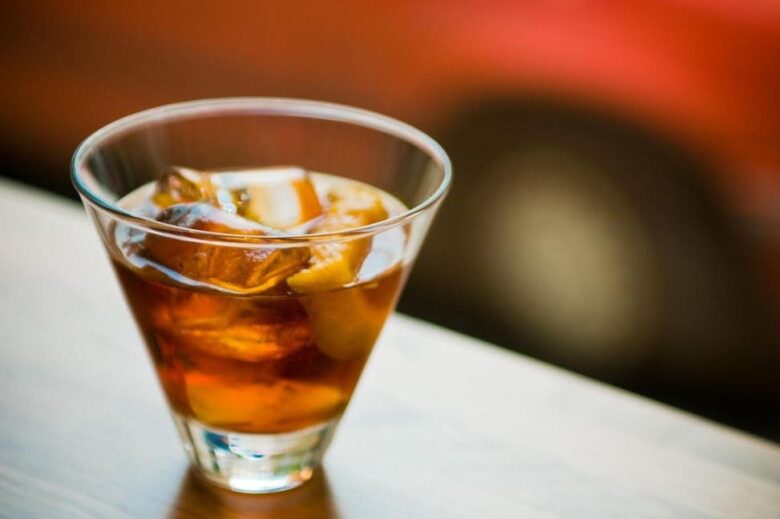When I was in high school, I got my one and only cocktail lesson from my dad. While making a drink, he turned to me and asked if I knew the difference between a dry martini and a very dry martini. He grabbed the (dusty) dry vermouth bottle from under the sink – probably next to the Comet and dish soap – and told me for a dry martini, you add 1/2oz dry vermouth to the vodka (he was a vodka drinker). In an extra dry martini, you just pass the glass of vodka next to the bottle of vermouth – clinking the glass together as they pass. Classic dad humor. Fast forward to three years ago, and my wife and I were taking a food tour of the neighborhoods of Barcelona, and on one of our stops, our guide brought out a glass of Vermut, on the rocks, with a slice of orange. It was incredible. She told us it was the Catalonian national drink – and the civilized way to experience a 2-hour Barcelona lunch was sitting at a bodega, eating pinchos (a Catalonian version of tapas), and sipping Vermut. You mean like sweet vermouth, I asked? She gave me a look as if I hadn’t been listening and told me no . . . nothing like that.
Everyone knows what vermouth is. But very few people know anything about it. Vermouth originated in the 1700s in Turin, Italy. It is a fortified wine, as opposed to a spirit, and is made by adding alcohol (typically unaged grape brandy) and all sorts of dry ingredients to a neutral white wine base. These dry roots, herbs, and barks infuse botanicals into the wine, and it is sweetened with cane or caramelized sugar (depending on the style). Wormwood was originally a common ingredient in the fortified wine (less so now), and its name is a bastardization of the German term for wormwood – ‘Wermut’. You have no doubt had vermouth many, many times – but likely can’t really describe it. That’s for good reason. Vermouth is happy to play a supporting role in a cocktail – giving a little bitter, a little spice, possibly some vanilla – but letting the primary spirits shine.

Vermouth, like its cousins the Amaros, was created as a form of medicine in northern Italy. Placing healthy medicinal herbs, barks, and roots in a shelf-stable vehicle, that is easily consumed. And like beer (hydration), wine (ceremonial), amaros (medicine), and even the cocktail (hangover cure), they all found their way into alcoholic based drinks – consumed for fun. By the mid-1800s bartenders were looking for anything to create the next big thing in drinking, and vermouths entered the scene in the last half of the century. At the time, the terms sweet and dry were not associated with vermouth. The first cocktail book, written by Jerry Thomas in 1962, references French vermouth (white/dry), and Italian vermouth (red/sweet) – the type created by each country.

Sweet vermouth (rosso) is the granddaddy, created by Antonio Benedetto Carpano in 1786 (the Carpano Anica is said to be the original formula, and is considered one of the best sweet vermouths on the market). The Italian (and Spanish) vermouths are called red and sweet, but in reality – they are neither. They pour more of a deep, red-tinted brown, and have a little residual sugar, but the flavor profile is primarily aromatics, and not sweet. It is the cornerstone of many classic cocktails, such as the Manhattan, but is still considered an apéritif, and drunk in the afternoon or before a meal by itself or over ice. The word apéritif is French, and derived from the Latin term for open, or to open up, and is used to wake the digestive system prior to a meal.

Dry vermouth followed and was created first by Dolin in 1815 when Joseph Chavasse opened the first distillery on the Savoy region. Dry vermouth has less residual sugar and tends to be lighter and more herbaceous than its Italian counterpart and has a light to medium body. You cannot make a dry martini without dry vermouth. The region also created the White/Blanc/Bianco vermouth, which hits somewhere in the middle. It is less well known, and while it looks like dry, it is semi-sweet, and has a nice acidity that balances the underlying bitterness. The Dolin Blanc has become one of my favorite vermouths.
While it is simple to think of vermouth in these nationalistic silos, red/sweet/Italian – white/dry/French, the distinctions have pretty much gone away. Most companies make both types, and there has been an explosion of niche vermouth craft distilleries popping up across the globe.
The best way to get to know them is to try them. They were created to be consumed alone, so you can enjoy a small glass before dinner and convince yourself that what you are doing is for your health. Apéritifs and amaros have a bitterness to them, and humans are hard-wired to avoid the flavor – the taste of many poisonous plants and herbs. The evolutionary response by the brain to the taste is to send out signals to stimulate digestion in the body. It is not just an excuse to drink.

So maybe the Italians and the Catalonians in eastern Spain have the key to a happy life figured out. Spend the afternoon in a sidewalk café or bodega, sipping away at a low-alcohol vermouth on the rocks, snacking, playing cards or dominos, and watching people stroll by. Or maybe you can just stick with eating a fast food burger at your desk at lunch.
Oh, and one more thing. If you have an old bottle of vermouth in a cabinet somewhere, possible behind the Crème de Menthe you bought in 2007 for that holiday drink – toss it. Vermouth is wine-based, and while it is fortified, it is not scotch. At room temperature, a dry vermouth will last two to four weeks, a red up to two months. But it will not still be at its prime. Store it in the refrigerator and you can double that timeframe.
Cheers!
- Bill Stott
Recipe for The Dirty Martini:
AotCB-020
Instagram@architecture_of_the_cocktail



